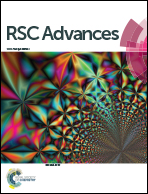DOX-Fe3O4@mSiO2-PO-FA nanocomposite for synergistic chemo- and photothermal therapy†
Abstract
The integration of multiple therapies into one nanoplatform was considered to be the most efficient method to give an enhanced therapeutic effect for anti-cancer treatments. In this research, pH sensitive drug release and near-infrared (NIR)-induced photothermal therapy (PTT) were placed in one nanocomposite using iron(II,III) oxide@meso-silica (Fe3O4@mSiO2) NPs as the host. Then, a sensitive ketal modified silane coupling agent (PO linker) was prepared to encapsulate the anti-cancer drug, doxorubicin hydrochloride (DOX), into the mSiO2 shell, ensuring the few leakage. Based on the different pH conditions of normal and cancer cells, the DOX-Fe3O4@mSiO2-PO nanocomposite exhibits the specific drug release in cancer cells (acid conditions) before that the few leakage makes sure there are a low number of side effects. Furthermore, the release kinetics can also be easily adjusted by varying the amount of PO linker. Under NIR (808 nm) irradiation, the photothermal effect derived from magnetic Fe3O4 NPs can also induce the apoptosis of the cancer cells which is how PTT is achieved. HeLa cells (cervical cancer cell line) were used as the typical cancer cell and the detailed cell experiments further display the enhanced specific cytotoxicity of the method to HeLa cells. The multifunctional nanocomposite has great potential as an application for anti-cancer therapy.


 Please wait while we load your content...
Please wait while we load your content...